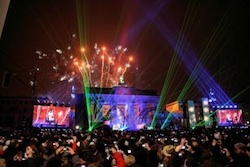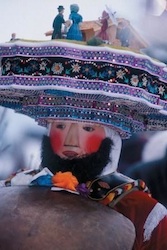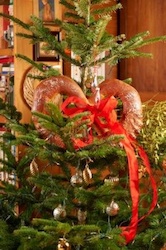Special Feature: Products Sally Recommends
New Year Celebrations Around The World
 With the hustle and bustle of Christmas now behind us, it’s time to turn our thoughts to the New Year and how best to celebrate.
With the hustle and bustle of Christmas now behind us, it’s time to turn our thoughts to the New Year and how best to celebrate.
For New Year’s Eve, plenty of bubbly and good friends, plus a designated driver, are usually part of the plan. For New Year’s Day, if you’re from the American South, black-eyed peas and ham are on the good-luck menu. But what are some other traditions?
Getting the Date Right
Celebrating the new year seems to be a worldwide phenomenon. However, not all countries or cultures celebrate the new year on Jan. 1. For example, the Chinese, Jewish and Muslim years all have different starting dates. The Christian calendar also has recognized different dates over the centuries.
The early Roman calendar designated March 1 as the new year. The calendar had ten months, beginning with March. January and February were added around 700 B.C. January was named after Janus, the god of gates, doors, beginnings and endings. Janus had two faces, one that looked ahead to see what the new year would bring, and the other that looked backward to see what had happened during the past year.
The first time the new year was celebrated on Jan. 1 was in Rome in 153 B.C. But this new date was not always observed, and the new year was still sometimes celebrated on March 1. In 46 B.C., Julius Caesar introduced a new, solar-based calendar. The Julian calendar started the year on Jan. 1.
In medieval Christian Europe, however, some new year traditions were considered pagan and as a result, Jan. 1 was not recognized as the beginning of the year. At various times and places, the new year was celebrated on Dec. 25, Christmas; March 1; March 25, the Feast of the Annunciation; or Easter.
After the introduction of the Gregorian calendar in 1582 by Pope Gregory XIII, most of Europe began the new year on the first day of January. But the Gregorian calendar was not adopted in German Protestant regions until 1700, and even later in many parts of the world, such as Britain in 1752 and Russia in 1918.
In Asia, the Lunar New Year starts on a different day each year; this year it begins on Feb. 10. The Jewish New Year, Rosh Hashanah, is celebrated around the time of the fall equinox, in late September. On the Muslim lunar calendar, new year’s day is the first day of the first month, Muharram. The Islamic New Year is observed quietly.
Ringing in the New Year
Here in the United States, the signature event for New Year’s Eve is the gathering at Times Square in New York City to watch the New Year ball descend at midnight. Millions across the country watch the festivities on television. The tradition of a kiss shared at the stroke of midnight is derived from masked balls; the masks symbolize evil spirits from the old year and the kiss is the purification of the new year. It may also have to do with this old saying, “On New Year's Eve, kiss the person you hope to keep kissing.”
In many countries, fireworks are the key element in new year celebrations, with spectacular light displays that illuminate the winter skies. People all over the world use fireworks to drive out evil spirits and usher in the new year.
In Berlin, the fireworks display over the Brandenburg Gate takes on special meaning because the gate was in no-man’s land behind the Berlin Wall for so many years. Now it is the heart of the city, and throngs will gather there for what is billed as the “biggest organized New Year’s Eve party in the world.” Almost a million Berliners and visitors are expected to celebrate along the two-kilometer “party mile” between the Brandenburg Gate and the Victory Column.
Similarly, in Switzerland, fireworks will light up the famous Chapel Bridge, or Kapellbrücke, in Lucerne, creating a picture-postcard scene.
 In many European countries, New Year’s Eve is often called Silvester. This is a reference to St. Sylvester, who was Pope from 314 until his death in Rome on Dec. 31, 335. From St. Sylvester’s feast day, Dec. 31, comes the term, Silvester, for New Year’s Eve.
In many European countries, New Year’s Eve is often called Silvester. This is a reference to St. Sylvester, who was Pope from 314 until his death in Rome on Dec. 31, 335. From St. Sylvester’s feast day, Dec. 31, comes the term, Silvester, for New Year’s Eve.
In the canton of Appenzell, one of Switzerland’s most picturesque new year traditions takes place on both Dec. 31 and Jan. 13, recognizing both Gregorian and Julian dates. The Silvesterklausen are men dressed in elaborate costumes with masks and huge headgear. The bell carriers, or Schaelli, carry large cowbells around their necks or on both their backs and chests. A few of the mummers are dressed as women, called Rolli, wearing round bells on leather belts. Some wear shaggy coats decorated with fir branches, moss and dried leaves, and demonic masks made of papier mache; they are called Wueeschte.
From dawn to dusk, the Silvesterklausen go from house to house, announcing their arrival by clanging their bells. At each site, they form a circle, ring their bells, and perform a wordless yodel, called Zauerli, then they wish the onlookers good luck in the new year. The mummers are usually rewarded with a beverage, which they drink with a straw because of the masks, or with money.
In Alsace, the French region along the Rhine River that has belonged to both France and Germany over the centuries, Christmas and New Year traditions draw on both countries. Strasbourg, Obernai and Colmar are three of the most beautiful Christmas cities imaginable, and each has Christmas markets that run through Dec. 31, providing entertainment to families and visitors throughout the holiday season.
 The pretzel is a symbol of Alsace, and is popular throughout the year, but especially at holiday time. Pretzels are thought to represent togetherness, limitlessness, luck and blessings. It is said that one can view the divine star three times through the openings in the pretzel.
The pretzel is a symbol of Alsace, and is popular throughout the year, but especially at holiday time. Pretzels are thought to represent togetherness, limitlessness, luck and blessings. It is said that one can view the divine star three times through the openings in the pretzel.
The traditional salted pretzel is the year-round standard, but on New Year’s Eve a sugared pretzel made of brioche dough is a ritual gift from a young man to his lady love. On New Year’s Day, grandparents give sugared pretzels to their grandchildren.
Good Luck Rituals
Here are more good luck rituals from around the world, compiled from various sources. They are believed to bring good fortune and prosperity in the coming year.
Austria: The pig symbolizes good luck. The New Year menu often includes suckling pig. Miniature pigs made of marzipan, cookie dough or chocolate are popular.
Belgium: New Year's Eve is called Sint Sylvester Vooranvond or Saint Sylvester Eve. At midnight at the réveillon, or New Year's Eve party, everyone kisses, exchanges good luck greetings, and drinks toasts to absent relatives and friends.
Brazil: The lentil signifies wealth, so on the first day of the New Year, Brazilians serve lentil soup or lentils and rice.
Denmark: It is a good sign to find your doorstep heaped with a pile of broken dishes on New Year’s Day. Old dishes are saved all year to throw at friends’ homes on New Year’s Eve. Lots of broken dishes are a sign that you have many friends.
England: The English place their fortunes for the coming year in the hands of their first guest. Traditionally, the first visitor of each year should be male and bearing gifts. Traditional gifts are coal for the fire, a loaf for the table and a drink for the master. For good luck, the guest should enter through the front door and leave through the back door. Guests who are empty handed are not allowed to enter first.
The English followed the custom of cleaning their chimneys on New Year’s Day to bring good luck to the household for the coming year. The expression "cleaning the slate" came from this custom.
Germany: Lead pouring is an old practice that uses molten lead like tea leaves. Molybdomancy is an ancient technique of divination that involves interpreting the shapes formed by dropping melted lead into cold water. A small amount of lead is melted in a tablespoon (by holding a flame under the spoon) and then poured into a bowl of cold water.
The resulting shape of the lead is interpreted to predict the coming year. For instance, if the lead forms a ball, it means luck will roll your way. The shape of an anchor means help in time of need. A heart or ring shape means a wedding, a ship means a journey, and a pig means plenty of food in the year ahead. Lead pouring is also popular in Finland.
Greece: Jan. 1 is an important date in Greece because it is not only the first day of the New Year, but it is also St. Basil's Day. St. Basil was one the forefathers of the Greek Orthodox Church and is remembered for his kindness and generosity to the poor.
On New Year’s Eve, families gather for a meal of roast lamb or pork. An extra place is set at the table for St. Basil. An onion is hung on the front door -- alongside a pomegranate that has been hanging there since Christmas -- as a symbol of rebirth and growth. Around midnight, the family turns off the lights and goes outside. One person takes the pomegranate and smashes it against the door as the clock strikes midnight.
Hungary: An effigy or scapegoat known as Jack Straw, which represents the evils and misfortunes of the past year, is carried around the village, then burned on New Year's Eve.
Italy: Food plays a major role in New Year celebrations in Italy. The evening begins with the traditional dish, cotechino e lenticchie. Cotechino is a savory pork sausage that contains lo zampone, a pig’s foot, and is a symbol of abundance. Lenticchie (lentils) are believed to bring good luck and prosperity in the coming year.
In the past, people would throw old personal effects out the windows and smash plates, glasses, vases and other pottery against the ground to drive away bad spirits.
Japan: Since 1873, the Japanese New Year, or shogatsu, has been celebrated on Jan. 1, but originally it followed the Chinese lunar calendar. The New Year’s Eve celebration includes countdowns, concerts, fireworks and food.
Around 11 p.m., people gather at home for one last time in the old year to eat a bowl of long noodles. Long noodles are associated with crossing over from one year to the next.
At midnight, Buddhist temples across the country ring their bells108 times. At the Zojoji Temple in Tokyo, thousands of people release helium balloons carrying New Year’s wishes into the sky.
Mexico: To start the year with a clean slate, people write a list of all the unhappy events that happened during the year, then throw the list into a fire before midnight to eliminate the negative feelings of the past year.
Mexican sweet bread is baked with a coin or charm hidden in the dough. Whoever gets the slice with the coin or charm is said to be blessed with good luck for the New Year.
Norway: Norwegians prepare rice pudding with one almond hidden inside. The person whose serving contains the lucky almond is assured wealth in the coming year.
Philippines: On New Year’s Eve, many Filipinos wear clothes with dots -- because circles attract money and fortune -- and bright colors -- to show enthusiasm for the coming year. Throwing coins at the stroke of midnight, serving round fruits, and shaking coins inside a metal can while walking around the house are all believed to increase wealth in the coming year.
Scotland: Hogmanay, the Scottish new year celebration, has roots that date back to the celebration of the winter solstice and the Celtic feast of Samhain. The most widespread Hogmanay custom is “first-footing,” which starts immediately after midnight. First-footing involves being the first person to cross the threshold of a friend’s home bearing symbolic gifts such as salt, coal, shortbread, whisky or black bun (a rich fruit cake) to bring luck to the household. Tradition varies, but desirable “first-footers” typically include new brides, new mothers, those who are tall and dark, and anyone born on Jan. 1.
Sicily: An old Sicilian tradition says good luck will come to those who eat lasagna on New Year's Day, but eating any type of noodle other than lasagna will bring bad luck.
Spain, Portugal and Peru: When the clock strikes midnight, the Spanish and Portuguese eat 12 grapes, one with every toll, to bring good luck for the 12 months ahead. In Peru, a thirteenth grape must be eaten to assure good luck.
Wales: At the first toll of midnight, the back door of the house is opened and then shut to release the old year and lock out all of its bad luck. Then at the twelfth stroke of the clock, the front door is opened and the New Year is welcomed with all of its luck.
Calennig, the Welsh name for New Year, means celebration or gift. Since ancient times, the tradition in Wales has been to give gifts and money to friends, family and neighbors. Children rise early to make the rounds to their neighbors and sing songs, for which they are given treats.
Here’s a Toast
My plans for a fondue party on New Year’s Eve seem to fade in comparison to these exciting traditions from around the world. But at least we can offer a toast, German style.
Raise your glass with me and salute the New Year: “Prosit Neujahr” – “May the New Year turn out well.” Let’s drink to that.
Photo Credits
Photo 1, Fireworks over Brandenburg Gate: Almost a million people are expected at this year’s New Year’s Eve celebration near the Brandenburg Gate in Berlin. The open-air party includes live bands, disc jockeys and spectacular fireworks. Credit: SpreePix Media
Photo 2, Appenzell: Elaborate bonnets, masks and costumes are the sign of the Silvesterklausen mummers who appear on New Year’s Eve in Appenzell in Switzerland. Credit: Switzerland Tourism/Daisy Gilardin
Photo 3, Pretzel: Sugared pretzels are an Alsace tradition for the New Year. Credit: CRTA/Creutz
Article copyright 2012 by Barbara Gibbs Ostmann.
![]()
St. Louis-based Barbara Gibbs Ostmann enjoyed the New Year Celebrations Around the World.
Note: This information was accurate when it was published. Please be sure to confirm all rates and details directly with the businesses in question before making your plans.



